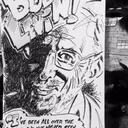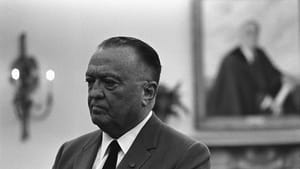Stay in the Loop
BSR publishes on a weekly schedule, with an email newsletter every Wednesday and Thursday morning. There’s no paywall, and subscribing is always free.
Before Daniel Ellsberg, before Edward Snowden, were the Media burglars. On March 8, 1971, eight nonviolent antiwar activists broke into the FBI’s Media, Pennsylvania office and walked out with its files. Over the next two months, they revealed portions of the files to members of Congress and the press.
Those revelations led to a wrenching rethinking of the role of investigative agencies in a democracy; a reform (some would insert a prefatory “insufficient”) of their practices; and an unmasking of J. Edgar Hoover, the FBI’s director for 48-years, as a (some would also say) corrupt, deceitful, law-breaking, bullying, homicidal paranoid. Which proved insufficient to strike his name from the bureau’s national headquarters.
Naming names
Despite a 200-agent-strong investigation, the burglars remained uncaught and unknown, until 2014, when Betty Medsger, the Washington Post reporter who had broken the story, published The Burglary, which named five of them. (Two, whom Medsger also interviewed, requested anonymity. One could not be found but surfaced in time for the softcover edition.) They were three women and five men, ranging in age between 19 and 44, college professors and college drop-outs, veterans of draft board break-ins and rookie felons-in-waiting. They hoped to document FBI efforts to cripple the antiwar movement. They achieved, Medsger writes, “perhaps the most powerful single act of nonviolent resistance in American history.”
How they carried out their mission — via lock-picking classes and escape-route maps, decoys and safe houses, casings of the office interior and stakeouts of the surrounding streets — and how the FBI failed to capture them — despite analyzing everything from Xerox machines to staples, with cliff-hanging near misses and near-slapstick ineptness — makes a narrative as thrilling as any caper movie. The concluding whatever-happened-tos resolve the burglars’ individual stories, and a rousing digression into the trial of the not-unrelated Camden 28, could warrant a book of its own. (Philadelphians may take pride in Medsger’s assessment that its peace movement may have been “the largest . . . most active, and most diverse in the nation.”)
Riddled with informers
The Media files established that, for Hoover, skin color was sufficient grounds for suspicion, leading him to unleash one illegal investigation after another. Black organizations, churches, and high school and college groups were riddled with informers, and members’ First and Fourth Amendment rights were routinely violated. Programs that were only indirectly referred to in the files, though, provided the clues that led journalists and, later, legislators through Freedom of Information Act requests and lawsuits and subpoenas to reveal the extent of FBI evil.

Defying orders of his superiors, Hoover had maintained for decades a list of “enemies” he planned to round up and imprison in times of national emergency. Though this “emergency” never materialized, and this list remained his personal fantasy football game, those whose opinions or lifestyle offended the director risked blackmail, wiretaps, false arrests, burglaries of their homes, and buggings of their bedrooms. Their mail could be opened and their bank, college, credit, and medical records inspected. They could be publicly humiliated and fired from jobs on the basis of lies. They had their snacks doped and were tempted by prostitutes with VD. They could be convicted of capital crimes on false evidence and pressured into suicide and heart attacks. Groups could be set murderously against one other, and police fed information leading to individuals being murdered while they slept.
The enormity of these crimes makes the domestic offenses of the post 9/11 national security state, which Medsger tacks into, as if guided by an editor advocating “relevance,” look enlightened. These more contemporary excesses have been well reported elsewhere, and I wish she had stuck to her core story. It is all the lesson against overreaching government one needs.
What’s the difference?
That story also raised for me one (probably perverse) question. Is there a significant distinction between antiwar protestors who burglarize an FBI office and FBI agents who burglarize an antiwar one? I don’t believe that one group’s motivation being that it is saving its country’s soul and the other’s that it is saving its country from international Communism is dispositive. (In fact, extending my perversity, one could argue that the FBI was acting in furtherance of policies of a democratically elected government, while the activists, who were placing their beliefs above those of the majority of their countrymen, were demonstrating a less seemly arrogance.)
Still, I favor the activists. They acted as private citizens, while the FBI acted as representatives of the government. This infused the activists with an ennobling courage, for they knew, if they were caught, which was likely, they faced significant punishment. The agents knew, if they were caught, which was unlikely, they would not suffer much. (In fact the only two FBI men convicted of any of these crimes speedily received presidential pardons.) And as Justice Brandeis wrote, in Olmstead v. United States, “Our government is the . . . omnipotent teacher. For good or ill, it teaches the whole people by its example. . . . If the Government becomes a lawbreaker, it breeds contempt for the law; it invites every man to become a law unto himself; it invites anarchy.” Or as my friend Budd said, “Defiance of power is not the same as abuse of power.”
Which raises a deeper question. What made these eight people act? They were regular folks. How did they come to this courage, which, in three cases, even put their children’s futures at risk? Out of all those who opposed the war, what was special about them? Medsger allows the participants to explain themselves, and their degrees of insight and persuasion, which vary, never completely satisfy.
She avoids analysis herself, and the assertion of her sole outside expert, a criminal defense attorney (who says at “certain points in history, where a society goes so wrong . . . certain people . . . will say, ‘I won’t stand for that... I will risk career, life, limb, family, freedom’”) only more elegantly states the question, rather than answering it. I am left shaking my head in admiration of and gratitude for their undertaking.
What, When, Where
The Burglary: The Discovery of J. Edgar Hoover’s Secret FBI by Betty Medsger. Vintage, 2014. Available at Amazon.
Sign up for our newsletter
All of the week's new articles, all in one place. Sign up for the free weekly BSR newsletters, and don't miss a conversation.

 Bob Levin
Bob Levin
